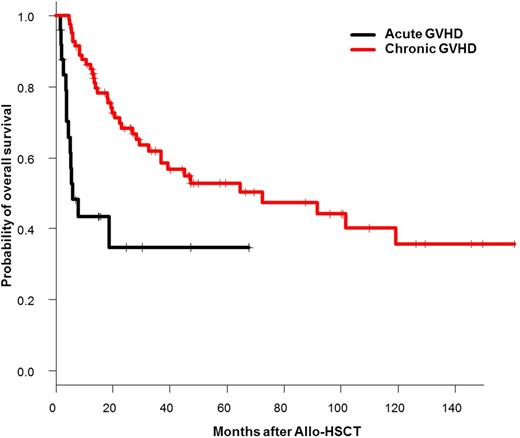Abstract
Graft-versus-host disease (GVHD), and complications of its treatment are the major causes of morbidity and mortality following allogeneic hematopoietic cell transplantation (allo-HCT). Even with the use of standard GVHD prophylaxis with classical administration of Anti-thymocyte globulin (ATG), calcineurin inhibitors (CNIs) and methotrexate, the incidence of acute and chronic forms of GVHD remains not negligible. Extracorporeal photopheresis (ECP) has shown very promising results as curative strategy for GVHD but also when used prophylactically.
The primary objective of this observational study was to perform an exhaustive description concerning patients receiving ECP after steroid resistance for either acute or chronic GVHD following allo-HCT, secondary objectives were to evaluate the efficacy and long-term outcomes.
We included 106 patients who underwent allo-HCT between years 2001 and 2016, 65 (61%) were males, median age at allo-HCT was 52 years (20-67). Major diagnoses were acute leukemias (N=48, 45%), myelodysplastic syndromes (N=18, 17%) and multiple myeloma (N=12, 11%). Before transplantation, 56 (53%) patients were in complete remission or in chronic phase. Donors were identical siblings in 51% of patients, matched unrelated in 24%, mismatched unrelated in 24% and haploidentical in 1%. Cells source was peripheral blood in 65%, bone marrow in 27% and cord blood in 8%. Conditioning regimens were of reduced intensity in 62% and myeloablative in 38%. ATG was used during conditioning in 67% of patients. GVHD prophylaxis consisted on cyclosporine A (CsA) alone in 22 (21%) patients, CsA + mycophenolate mofetil in 29 (27%), CsA + methotrexate in 28 (26%), the rest received other combinations.
In acute GVHD, first treatment consisted in methyl-prednisolone 2mg/Kg/day in combination with CNIs; and in chronic GVHD, it was methyl-prednisolone 0.5 - 1 mg/Kg/day + CNIs. ECP was performed using peripheral venous access. The ECP used the CELLEX system from Therakos®. ECP was initiated after transplantation either for acute GVHD [N=25 (24%), 12 grade III and 13 grade IV] affecting skin alone (N=5), gut alone (N=12), gut + liver (N=8); or for chronic GVHD [N=81 (76%), 15 (14%) limited and 66 (62%) extensive]. A total of 3300 ECP sessions were performed, majority (N=91, 85%) were twice a week; the median number of sessions/patient was 22 (min: 2, max: 132) for a median duration of 2.5 months (range: 0.5-48). ECP response evaluation was assessed after 4 weeks of treatment, patients were considered responding to ECP if more than 50% resolution of clinical GVHD manifestation of the organ involved was registered.
Among the 25 patients treated for acute GHVD, one was not evaluable because of disease progression and early death, 16/24 (67%) were responders to ECP and 8/24 (33%) were not responders and died later from GVHD associated to other complications. Among the 81 patients with chronic GVHD, 63/81 (78%) were responders and had tapering of ECP, the remaining 18 patients had limited response were associated to infection, had other complications and died later. Of note, in both forms of acute and chronic GVHD, responding patients had more skin or mucosa forms whereas non-responding patients has more organ-involved forms especially liver and gut.
After a median follow-up of 21 months, 52 (49%) patients are alive and 54 (51%) died with 39 (24%) from TRM causes (26 of them from GVHD) and 13 (26%) from relapse. Patients with acute GVHD had a median OS of 6 months with a survival probability at 2 years of 35% [95%CI: 14-56], those with chronic GVHD had a median OS of 72 months with a survival probability at 2 years of 68% [95%CI: 56-78]. The cumulative incidence of relapse for the whole population at 2 years was 16.7% (95% CI: 10-24), when stratifying according to the GVHD group, patients with chronic GVHD had lower relapse rate at 2 years with 12.6% (95% CI: 6-21) versus 31% (95% CI: 13-52) for those with acute GVHD, p=0.05.
In conclusion, we confirm that ECP is an effective treatment for GVHD with overall response rate of more than 74%. Interestingly, we observed a low relapse incidence in patients receiving ECP for longer time as in the case of chronic GVHD, which could be related to the GVL effect itself but also a possible involvement of the ECP. As patients with advanced phase of GVHD were poor responders, we suggest that an early use of ECP in the acute phase of the inflammation before organ damage, could lead to optimal results.
Nicolini: Incyte Biosciences: Honoraria, Speakers Bureau; BMS: Consultancy, Honoraria, Speakers Bureau; Novartis: Consultancy, Honoraria, Research Funding, Speakers Bureau; ARIAD: Honoraria, Speakers Bureau.
Author notes
Asterisk with author names denotes non-ASH members.


This feature is available to Subscribers Only
Sign In or Create an Account Close Modal